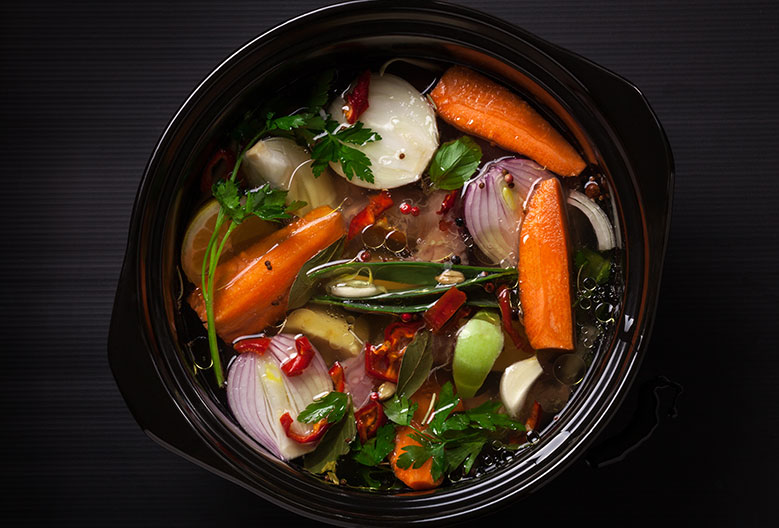So what is the difference between a stock and a bone broth?
You may be hearing the buzz on bone broths and their health benefits. Call it a fad but they are actually a staple in many cultures cuisines throughout the world. Stocks and broths have become the foundation of home cooking and are used in not only making soups and stews but also for preparing reductions, sauces and for braising vegetables and meats. Every home cook should have some on hand.
Stock
Stock is often made of bones and meat. This meat is crucial for flavor. The bones can be roasted first, but if you are short on time this is not necessary. Vegetables are added (or solely used in vegetable stock), everything is covered with water then simmered for a moderate amount of time, usually 3-4 hours. This broth is gelatin rich.
Bone broth
Bone broth is typically made of bones with a small amount of meat attached. As with stock, bones can be roasted first to intensify the flavor of the broth. Bone broths are simmered for a long period of time, 24 hours or longer. The long cooking period produces a denser, collagen rich broth full of minerals pulled from the bones and joints. The broth is done when the bones fall apart when touched, or snap easily in half.
Bone broth has a longer list of ingredients so it tastes good on its own, whereas stock is an added flavor enhancer used in preparing more complex dishes. Bone broths and stocks both support the adrenals, bones, and teeth. They are rich in protein, glycine and gelatin– all bonus benefits to add to a delicious meal!
Making your own stock and bone broth is actually very inexpensive, healthy, and simple to prepare. It takes a bit of a time, so prepare a large batch or two on a rainy day. They last for up to four months in a freezer or 5 days in the refrigerator.
Here are a few basic recipes to get you started:
Chicken Stock:
Ingredients
- 1 leftover roast chicken carcass
- 1 bay leaf
- 1 whole white onion (peeled and cut in half)
- 1 stalk celery (washed)
- 1 carrot, peeled
Instructions
- Add the chicken carcass, vegetables and bay leaf to a heavy bottomed pot.
- Pour filtered water over the carcass to cover.
- Cook over medium-high heat until stock just reaches a boil. Turn to low and let simmer for 3-4 hours. While simmering, occasionally skim fat and foam from the top using a ladle.
- By adding water to the pot, you can continue to cook the broth until the chicken flavor is robust and the carcass is falling apart.
- Strain the broth through a fine mesh strainer and pour into heatproof storage containers.
- The broth should cool completely in the refrigerator before covering and freezing.
TIP: Keep a zip lock bag of stock fixings in the freezer. Add any stock vegetables, meat bits or left over trimmings like chicken wings to the bag. Once it is full, put the contents in a heavy bottomed pot and cover with water. Follow the instructions above.
Beef Bone Broth:
Ingredients
- 1 ½pounds bone-in beef short rib
- 2 ½pounds beef shank or oxtail
- 2pounds beef knuckle bones or neck bones, or a combination of both (or add 1 more pound beef shank or oxtail)
- 2 tablespoons extra-virgin olive oil
- 2 tablespoons tomato paste
- ¼cup apple cider vinegar
- 3 carrots, peeled and coarsely chopped
- 3 celery stalks, coarsely chopped
- 2 onions, halved and peeled
- 1(14.5-ounce) can tomatoes
- 1 head garlic (cut in half, roots removed)
- 2 bay leaves
- 1 bunch fresh flat-leaf parsley
- ½ bunch fresh thyme
- ¼ ounce dried shiitake mushrooms
- 1 tablespoon black peppercorns
Instructions
- Heat oven to 350 degrees. Place meat and bones in a roasting pan or on a large rimmed baking sheet. Drizzle with olive oil, turning to coat, then brush all over with tomato paste. Roast until browned, 30 to 35 minutes. They don’t need to cook all the way through, just develop some color.
- Put roasted meat and bones in a 12-quart stockpot and add vinegar and enough cold water to cover by 3 inches (about 6 quarts). Bring to a boil, then reduce to a low simmer, uncovered, for 2 to 3 hours. While simmering, occasionally skim fat and foam from the top using a ladle.
- Add all the remaining ingredients. Continue to simmer, uncovered, for a minimum of 3 hours. If using knuckle bones, simmer overnight, 9 to 15 hours, so the knuckle bones have sufficient time to break down.
- Pour broth through a fine-mesh strainer into heatproof storage containers.
- The broth should cool completely in the refrigerator before covering and freezing.
Adapted from “A Good Food Day” by Marco Canora

